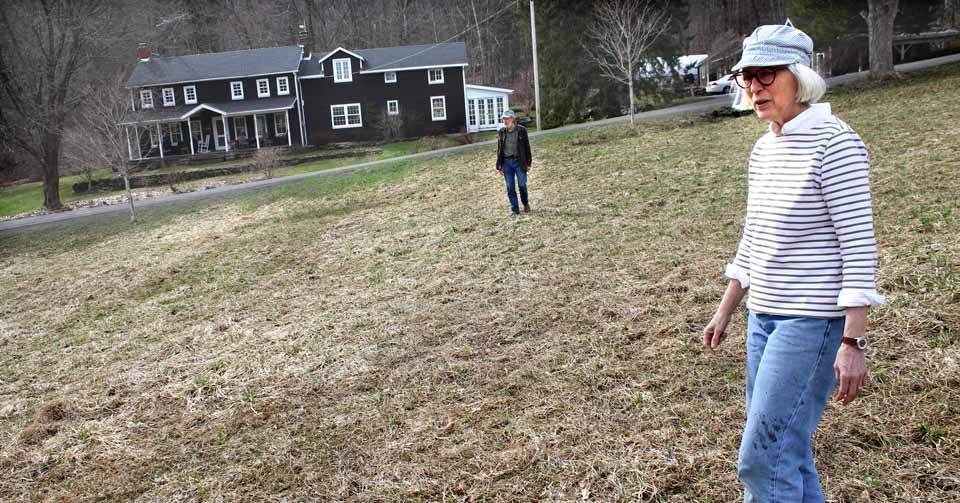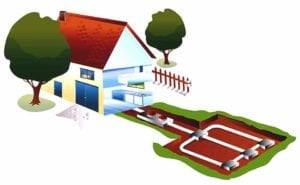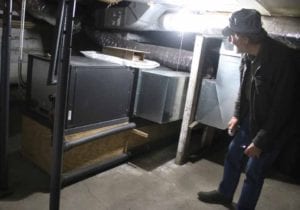HEAT from the EARTH
Geothermal Pioneers, Kuzminskis
Now Heat For Just $100 A Month

By LIBBY CUDMORE • Special to www.AllOTSEGO.com
FLY CREEK – Sitting on their front porch on a warm evening, Adrian and Antoinette Kuzminski can look out at the green field across the road from their home in Fly Creek Valley.
Or, looking at it another way, at their home heating and cooling system.

“We get our heat from the earth,” said Adrian. “We’ve had geothermal for more than five years.”
Inspired by his sister-in-law in Virginia, the couple installed a horizontal geothermal system in a square of that field about half the size of a football field.
Eight feet underground, water mixed with a “veggie-grade” anti-freeze is continuously pumped through a network of flexible plastic tubing.
“At that depth, the ground is always 55 degrees,” she said. “In the winter, the water courses through and picks up some of that heat.”
The water – now at 55 degrees – passes through the home-heating system in the basement, which compresses the water and releases that heat.
“It’s like a fridge in reverse,” said Kuzminski. “In the summer, the water carries the warm temperatures out of the house.”
Previously, the couple had been heating their home with two wood stoves. “We were using 16 face cords of wood every winter,” he said. “We also had an oil furnace that needed replacing, and that was going to be several thousand dollars.”
They did the calculations and realized that although the cost of a geothermal system was around $30,000, a $10,000

rebate helped, and they system would pay for itself in 13 years.
“It’s a lot easier to just turn up the thermostat than have to haul all that wood,” said Antoinette.
The price has come down since they purchased the system, Adrian said, and being underground, the system doesn’t include intrusive solar panels or windmills to disturb their view.
The only downside, he said, is an increase in their electric bill in the winter. “It’s about an extra $100 on our bill,” he said. “But we were spending $800-$1,000 on wood every winter.”
But even using more electricity, they’re still able to do so with an environmentalists’ conscience. “We’re on the electric co-op, and when we were considering this, we asked if it would mean burning more coal in order to run this eco-friendly system,” she said. “But the co-op buys hydro-power from Niagara Falls.”
A homeowner would still need a separate water heating system, but Leslie Orizetti, executive director, OCCA, said that a home solar system could provide that electricity.
“It’s a great way to get off fossil fuels,” she said. “Geothermal is the most expensive system, but the advantage is that it does heating and cooling.”
But the Kuzminskis aren’t the only ones using Mother Earth to heat and cool their home. Bennett Sandler, campaign director, HeatSmart Otsego, estimates that between 20-30 residencies – including ones in the city of Oneonta – are using geothermal, as is Sidney Federal Credit Union and Revolution Solar in Middlefield.
“They’re highly incentivized,” said Sandler. “There is a 30 percent tax credit, a $1,500 per ton rebate – most systems are between four to six tons – and a National Grid rebate. It’s expensive up front, but it pays for itself in about five to ten years.”
In order to get a system installed, an energy audit must first be done on the house. “You have to have an assessment of a home’s energy needs,” said Antoinette.
Once that is done and found to be sufficient, the system still runs between $20,000-$25,000 to install. “The technology to put it in is still very primitive,” said Adrian. “It’s clunky, like putting in a well.”
Though the horizontal system takes up a considerable amount of space, Antoinette says that a vertical system can be installed under a driveway. Systems can also be installed in ponds.
“The pond has to be at least 10 feet deep to put in a heat exchange,” said Sandler. “It can’t be a cattle pond.”
The Kuzminskis’ system was installed by Aztech in Ballston Spa, part of their commitment to environmentally friendly living that includes an electric-hybrid car – charged at non-peak hours – and even a hot tub that runs on burning wood, rather than using up electricity.
If interested, Sandler and HeatSmart Otsego are running a community campaign to match homeowners with installers at www.heatsmartotsego.com.
“It’s been a blessing,” said Adrian. “It’s all about quality of life”

